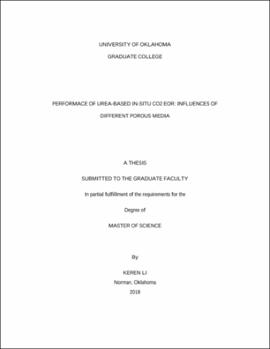| dc.description.abstract | Carbon dioxide (CO2) flooding has been proved as a successful method for enhanced oil recovery (EOR) in oil fields globally in recent decades. However, significant growth of applying CO2-EOR technology is largely restricted by factors such as limited natural source of CO2 and transportation, viscous fingering, gravity override at the reservoir and corrosion of equipment. To avoid some of these limitation issues, an improved in-situ CO2 gas generation technique for EOR was studied in this thesis research work, through a series of controlled laboratory scale experiments under various in-situ conditions. In this work, urea was chosen as potential CO2 generation candidate, because of its exceptional high aqueous solubility, and robust decomposition mechanisms to carbon dioxide and ammonia products at appropriate reservoir conditions. Once formed, the produced CO2 in aqueous brine easily migrates to the trapped oil phase due to its rather high solubility in oil. These ongoing mass transfer processes cause oil phase swelling and decreasing oil viscosity, therefore results in significant increase of oil production. At the meantime, the dissolved ammonia generated in the aqueous phase would offer additional benefits similar to that of a common alkaline injection. Ammonia could react with polar petroleum acids in crude to produce surfactants in-situ which not only decreases the interfacial tension between oil and water, but also leads to a better sweep efficiency as a result of emulsion generation. Meanwhile, the alteration of wettability in both sandstone and carbonate rocks was evidenced at elevated alkalinity.
Performances of urea-based tertiary recovery were conducted in a series of flow-through tests maintained at back pressure of 1500 psi and temperature of 125 oC. Several light crude oils (API around 40) and pure dodecane were used as representative oil system. The chemical concentrations of injecting urea and single alkaline, ammonium hydroxide, were pre-determined at 35 wt% and 15 wt%, respectively. After reaching the residual oil saturation following initial (sea)water flooding, the chosen steps of 1+1 pore volume of chemical slug injection were executed sequentially into the steel column device and immediately followed by two shut-in cycles, each shut-in cycle lasted 72 hours. The best tertiary recovery performance was recorded in sandstone media, varying from 5.17% to 26.09%, followed by the cases of limestone, ranging 0% to 12.37%, and the least dramatic in case of dolomite, close to 9.72%. The predominant mechanisms of urea-based EOR formulations observed in this study involve oil swelling, viscosity reduction, IFT decreasing and wettability alteration. Regardless of the types of porous media used, injection of urea was capable of dramatically enhancing oil recovery as compared with those of conventional water floodings, and even competing with a regular supercritical CO2 flooding. It is worthy to note that tertiary recovery in carbonate formations might not be as drastic as that in sandstone media. Overall, proper design of urea-based in-situ CO2 system may potentially offer a superior EOR alternative to be applied in both onshore and offshore oil fields. | en_US |
